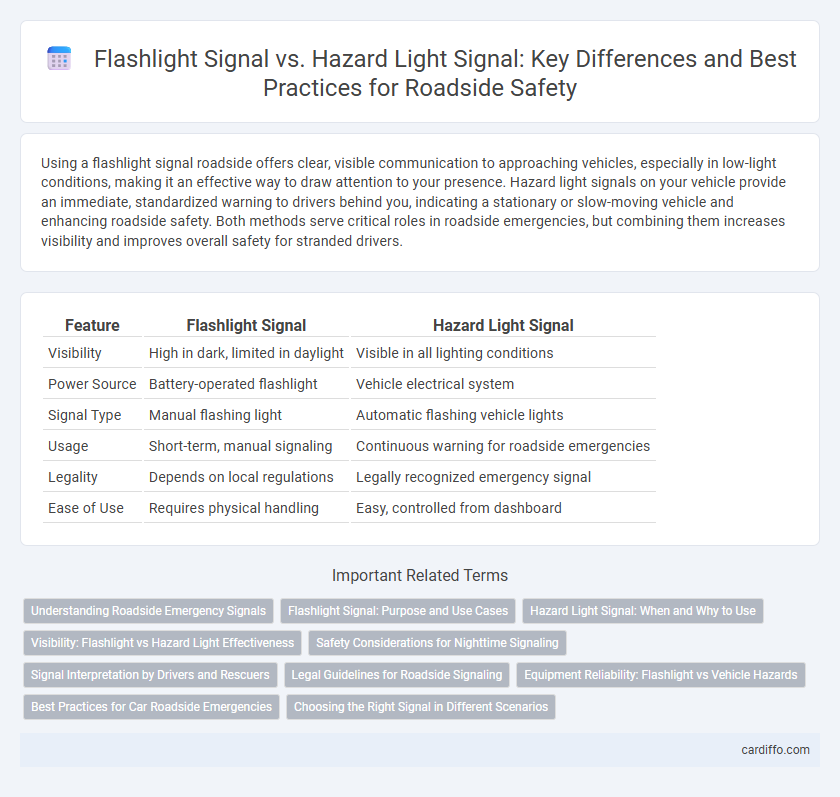Using a flashlight signal roadside offers clear, visible communication to approaching vehicles, especially in low-light conditions, making it an effective way to draw attention to your presence. Hazard light signals on your vehicle provide an immediate, standardized warning to drivers behind you, indicating a stationary or slow-moving vehicle and enhancing roadside safety. Both methods serve critical roles in roadside emergencies, but combining them increases visibility and improves overall safety for stranded drivers.
Table of Comparison
| Feature | Flashlight Signal | Hazard Light Signal |
|---|---|---|
| Visibility | High in dark, limited in daylight | Visible in all lighting conditions |
| Power Source | Battery-operated flashlight | Vehicle electrical system |
| Signal Type | Manual flashing light | Automatic flashing vehicle lights |
| Usage | Short-term, manual signaling | Continuous warning for roadside emergencies |
| Legality | Depends on local regulations | Legally recognized emergency signal |
| Ease of Use | Requires physical handling | Easy, controlled from dashboard |
Understanding Roadside Emergency Signals
Flashlight signals and hazard light signals serve crucial roles in roadside emergencies, each offering distinct advantages for alerting other drivers. Flashlight signals provide manual, visible cues that can be directed toward specific vehicles or areas, making them effective for personal signaling in low-light conditions. Hazard light signals automatically activate all turn indicators to warn nearby drivers of a stationary or slow-moving vehicle, enhancing overall visibility and safety during roadside stops.
Flashlight Signal: Purpose and Use Cases
Flashlight signals serve as a critical visual communication tool for roadside emergencies, enabling stranded drivers or pedestrians to attract attention and indicate distress in low-visibility conditions. Unlike hazard light signals that are integrated into vehicles and serve to warn surrounding traffic of potential dangers or stopped vehicles, flashlight signals are portable, versatile, and can be directed to specific individuals or rescuers. Common use cases include nighttime breakdowns, flagging down emergency responders, and guiding assistance on dark roads or off-road locations where vehicle hazard lights may be less visible.
Hazard Light Signal: When and Why to Use
Hazard light signals are used to alert other drivers of a potential danger or emergency situation, such as a breakdown, accident, or sudden stop, enhancing roadside safety by increasing vehicle visibility. Unlike flashlight signals, which rely on manual operation and are less visible, hazard lights provide a consistent, bright flashing light that can be seen from a distance, especially in low visibility conditions. Using hazard lights appropriately helps prevent collisions and signals caution, prompting surrounding drivers to reduce speed and proceed carefully.
Visibility: Flashlight vs Hazard Light Effectiveness
Flashlight signals provide a focused, handheld beam that can be directed precisely to attract attention in low-visibility roadside situations, making them highly effective for close-range signaling. Hazard lights emit a continuous, flashing light from multiple vehicle points, enhancing overall vehicle visibility from greater distances and multiple angles, especially useful on busy roads. For maximum roadside safety, combining flashlight signals with hazard lights ensures both focused signaling and broad visibility in diverse conditions.
Safety Considerations for Nighttime Signaling
Flashlight signals provide highly visible, directional light that can precisely indicate your location or intention during nighttime roadside emergencies, enhancing personal safety when used correctly. Hazard light signals on vehicles emit a consistent, blinking amber light that alerts other drivers to a stationary or slow-moving vehicle, increasing overall road awareness and reducing collision risk. Combining both signals maximizes visibility and ensures clearer communication to approaching traffic, critical for preventing accidents in low-light conditions.
Signal Interpretation by Drivers and Rescuers
Flashlight signals are manually operated by rescuers or drivers and often convey specific instructions or warnings through variations in movement, such as waving or steady shining, which require close interpretation based on context. Hazard light signals, activated by a vehicle's built-in system, universally indicate a stationary or emergency situation, prompting drivers to slow down and proceed with caution. Accurate interpretation of these signals enhances safety and response efficiency during roadside emergencies.
Legal Guidelines for Roadside Signaling
Flashlight signals and hazard light signals serve distinct legal purposes for roadside emergencies under traffic safety regulations. Flashlight signaling is often recommended by law enforcement for direct communication with other drivers or authorities, especially in low-visibility conditions, while hazard lights are legally mandated to alert surrounding traffic of a stationary or slowed vehicle. Compliance with specific jurisdictional statutes ensures that each signaling method is used correctly to enhance roadside safety and avoid legal penalties.
Equipment Reliability: Flashlight vs Vehicle Hazards
Flashlight signals provide a reliable and portable source of light that remains effective even when vehicle electrical systems fail, making them essential for emergency roadside use. Hazard light signals depend on the vehicle's battery and electrical circuit, which can be compromised during accidents, reducing their reliability. Combining flashlight signals with hazard lights enhances overall equipment reliability and visibility in roadside emergencies.
Best Practices for Car Roadside Emergencies
Using a flashlight signal is highly effective for increasing visibility during roadside emergencies, especially in low-light conditions, as the bright, focused beam can alert oncoming traffic from a distance. Hazard light signals provide a broader, more immediate warning to nearby drivers and should be activated first to indicate a stationary vehicle and reduce collision risk. Combining flashing flashlight signals with hazard lights enhances overall safety by maximizing visibility and communication of distress to all approaching vehicles.
Choosing the Right Signal in Different Scenarios
Flashlight signals offer portability and precise direction for roadside emergencies, ideal for alerting specific drivers or guiding traffic in low-light conditions. Hazard light signals provide an all-around visual warning, instantly recognizable to surrounding vehicles and essential for stationary hazards on busy roads. Selecting the appropriate signal depends on visibility, traffic conditions, and the urgency of communication to ensure maximum safety and effective roadside assistance.
Flashlight Signal vs Hazard Light Signal Infographic

 cardiffo.com
cardiffo.com